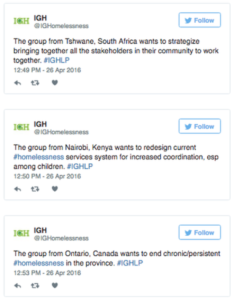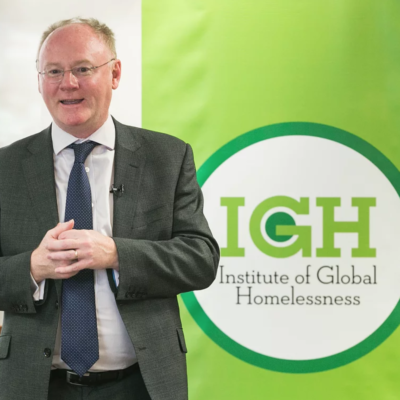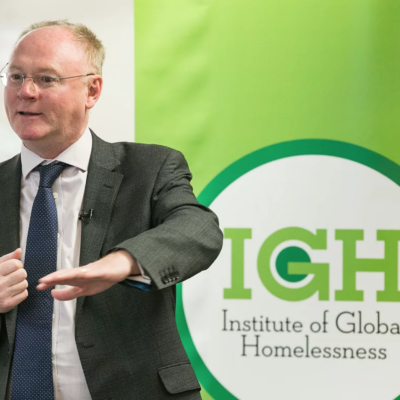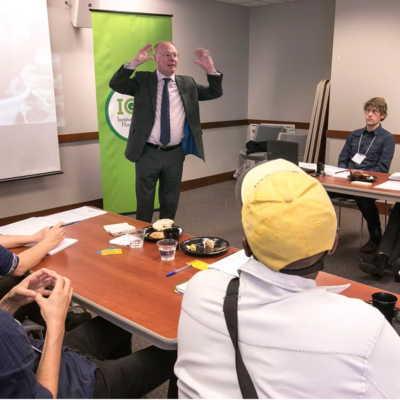The IGH Leadership Program cohort is building paper airplanes. Fourteen leaders in the homelessness sector from eight countries have split into three teams and they’re arguing over aerodynamics.
Paper planes seem so simple, don’t they? Take one sheet of paper, fold a few times, and voilà: flight. But anyone who has ever taken aim at the sky knows that takeoff rarely goes as planned. Sometimes the wind is too strong; sometimes the nose is too heavy; sometimes the airplane falls apart along the folds.
Of course, the history of flight is a history of falling. A history of changing track and trying again to reach new heights. Sometimes incremental changes–a new fold here, a different flick of the wrist–is enough to illuminate the whole system in a way that leads to a breakthrough. Sometimes it takes a lot of experimenting, failing, and re-calibrating to find the blueprint that works.
Flight Test 1: Experimentation
“Ours looks like a blimp,” says Isabel Lacalle, from Santiago, Chile. Her team has eschewed sleek aerodynamics in favor of weight and force. It’s not pretty, but it gets the job done. The two other teams have built their planes in a more traditional fashion, folding to a point and then anchoring the rear with paperclips.
The task at this point is to go from planning to testing as soon as feasible by adopting a mindset known as a Bias Toward Action. We won’t know how long the planes will go until we put them to the test.
 After each flight test, they will be given 5 minutes to experiment with a new design. Then they will go back to the starting point and take off again, hoping for an improved flight process and a longer landing. Ask anyone in the homelessness sector and they will tell you that change often happens in the form of small experiments that eventually lead to a breakthrough.
After each flight test, they will be given 5 minutes to experiment with a new design. Then they will go back to the starting point and take off again, hoping for an improved flight process and a longer landing. Ask anyone in the homelessness sector and they will tell you that change often happens in the form of small experiments that eventually lead to a breakthrough.
Drew Marshall from ExperiencePoint argues that there’s nothing wrong that kind of constant innovation. “We’re asked to do incremental innovation every day,” he says. “It’s an important part of any work.”
As IGH co-founder Mark McGreevy explains on the first day of the convening, “Change is about resilience. It’s about taking the long view. It’s about pressing on.”
The history of flight is a history of learning from failure. As Community Solutions facilitator Paul Howard puts it: “Don’t just accept that you’re going to make mistakes; embrace it. Use mistakes as opportunities to learn and improve by adopting a mindset of ‘Failing Forward’.”
Flight Test 2: Failing Forward
Team 2 needs more clips, more tape, and some scissors. Their plane only flew an additional half a foot during the previous trial, and this is their last opportunity. Perhaps clips can weigh down the rear of the plane; cutting slits in the wings may help the aircraft catch the breeze from the air conditioning.
“What’s a surefire way to improve our problem-solving and ingenuity?” asks Garen Nigon of Community Solutions. “Cultivate a growth mindset.”
A growth mindset acknowledges that where we are today is not a permanent state, and we can always change and improve. This helps leaders and organizations face failure with the understanding that you learn more from failure than from success. An issue as complex as homelessness requires a lot of on-the-go learning; there are no set answers that will work in 100% of cases. If you fold a piece of paper the right way, it will fly every time. Housing strategies have to allow for flexibility around each individual, and that kind of flexibility requires a particular kind of agility.
“Society treats complex problems like homelessness as if they were technical problems,” says Nigon. “But complex problems require flexible, creative approaches.”
Over the course of this year, all the leaders in our cohort will learn practical ways to achieve their goals. But more than that, they will cultivate the growth mindsets necessary to remain resilient throughout even the worst turbulence.
Flight Test 3: Breakthrough
 What if you could make something totally new? What if you could take a long, hard look at your homelessness services, bring in the perspectives of a wide range of users and stakeholders in the community, and come up with something that transforms an incremental system into a breakthrough system?
What if you could make something totally new? What if you could take a long, hard look at your homelessness services, bring in the perspectives of a wide range of users and stakeholders in the community, and come up with something that transforms an incremental system into a breakthrough system?
What if you could identify not just the needs your users and clients already know about, but also anticipate the needs they haven’t yet identified?
For three days, the IGH Leadership Program cohort is learning resilience in the face of incremental change, ingenuity at the opportunity for additive change, and new thinking to affect breakthrough change in their communities. Each country-level pair entered the program with a complex challenge they want to tackle at home.
Examples include ending family homelessness, building a multinational network of organizations working to end homelessness, completing an overhaul of national policy, and creating a comprehensive, coordinated system of homelessness services. (No small thinkers here.)
During the convening, each country-level pair turned these challenges into specific, time-bound breakthrough goals to point their learning toward.
After determining their breakthrough goal, teams were coached through the creation of concrete action plans to outline what steps they’ll need to take over the course of the program and beyond. What incremental changes will need to be tested and improved? What measurement will point toward success?
DePaul University/Jamie Moncrief
The program, split into three convenings and supplemented with facilitation, ongoing remote coaching, and support by Community Solutions and ExperiencePoint, is designed to help leaders:
-
identify new opportunities in their communities,
-
connect with their users to ensure that the new system meets their needs,
-
transform data into actionable plans, and
-
implement those ideas.
And though these long-term goals have due dates long after participants have graduated from the program, the work they do this year and the community of practice they will become part of after graduation will contribute to their efforts all the way to the finish line.
In the game of paper planes, resilience has paid off. On their third try, Team 1 and Team 3, despite radically different starts, end up going the same distance; Team 2 covers less than half the distance but lengthens their plane’s flight path 117% by the last trial.
In the entire history of flight, not one bird, not one plane, not one slip of paper has succeeded on the first attempt. The IGH Leadership Program teaches its participants not to be afraid of failing forward. Agile problem solving, creativity, and patience go a long way in the face of strong winds.
Fold and refold.
Try again.




